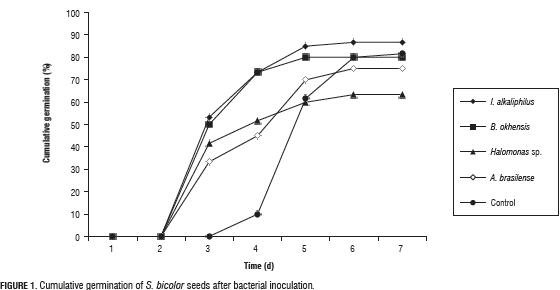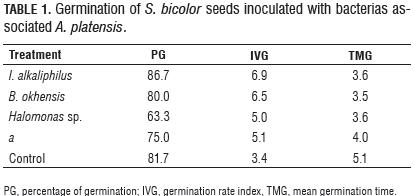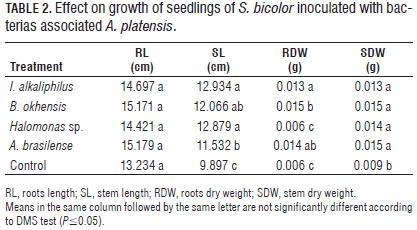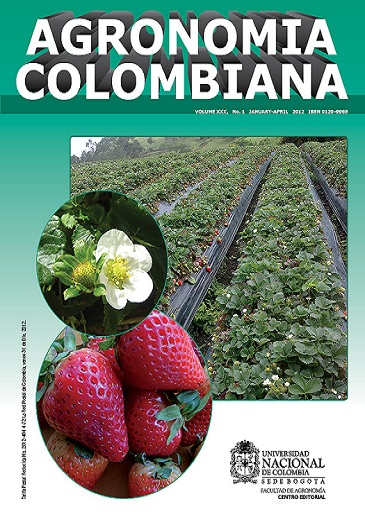Halotolerant/alkalophilic bacteria associated with the cyanobacterium Arthrospira platensis (Nordstedt) Gomont that promote early growth in Sorghum bicolor (L.) Moench
Keywords:
BPCV, fitohormonas, rizobacteria, microbiología agrícola, ácido 3-indol acético. (es)Downloads
Arthrospira platensis associated bacteria (APAB) identified through molecuar biology like Bacillus okhensis, Indibacter alkaliphilus and Halomonas sp., are also producing 3-indol acetic acid (IAA), these bacteria was used in early plant growth promotion tests over Sorghum bicolor, these bioassay was considered indirect evidence to suggest that APAB also may have stimulatory effects over A. platensis growth naturally. I. alkaliphilus and B. okhensis enhanced early germination of S. bicolor seads, with better results than that achieved by Azospirillum brasilense, bacterium used like reference as a common plant growth promoting rizobacteria. The three APAB enhanced significative differences (P≤0.05) over morphoagronomic parameters, I. alkaliphilus and B. okhensis exhibit better resoults in elongation stimulation and root and foliage dry weight. Above evidence suggest this bacteria like plant growth promoting and it recomended testing with A. platensis axenic cultures and its associated bactteri for understanding true interaction between them.
SOILS, FERTILIZATION AND MANAGEMENT OF WATER
1 Agricultural and Environmental Microbiology Research Group, Department of Natural Science, Universidad Popular del Cesar. Valledupar (Colombia).
2 Agricultural and Environmental Microbiology Research Group, Department of Microbiology, Universidad Popular del Cesar. Valledupar (Colombia).
3 Corresponding author. lilianagomez@unicesar.edu.co
Received for publication: 13 December, 2010. Accepted for publication: 1 March, 2012.
ABSTRACT
Arthrospira platensis associated bacteria (APAB) identified through molecuar biology like Bacillus okhensis, Indibacter alkaliphilus and Halomonas sp., are also producing 3-indol acetic acid (IAA), these bacteria was used in early plant growth promotion tests over Sorghum bicolor, these bioassay was considered indirect evidence to suggest that APAB also may have stimulatory effects over A. platensis growth naturally. I. alkaliphilus and B. okhensis enhanced early germination of S. bicolor seads, with better results than that achieved by Azospirillum brasilense, bacterium used like reference as a common plant growth promoting rizobacteria. The three APAB enhanced significative differences (P≤0.05) over morphoagronomic parameters, I. alkaliphilus and B. okhensis exhibith better resoults in elongation stimulation and root and foliage dry weight. Above evidence suggest this bacteria like plant growth promoting and it recomended testing with A. platensis axenic cultures and its associated bactteri for understanding true interaction between them.
Key words: PGPB, phytohormones, agricultural microbiology, indole-3-acetic acid.
RESUMEN
Bacterias asociadas a Arthrospira platensis (BAAP) identificadas a través de biología molecular como Bacillus okhensis, Indibacter alkaliphilus y Halomonas sp., productoras de acido 3-indol acético (AIA) se utilizaron en ensayos de promoción del crecimiento temprano de Sorghum bicolor como prueba indirecta para sugerir a las BAAP como estimuladoras sobre el crecimiento de A. platensis. Las bacterias I. alkaliphilus y B. okhensis favorecieron la germinación temprana de las semillas de S. bicolor, con resultados mayores que el alcanzando por Azospirillum brasilense bacteria utilizada como referencia y reconocida como promotora de crecimiento vegetal. Las tres BAAP registran diferencias significativas (P≤0,05) sobre parámetros morfoagronómicos, sobresalen I. alkaliphilus y B. okhensis en la estimulación del alargamiento y peso seco de raíces y follaje. Por lo anterior se sugiere que estas bacterias son promotoras de crecimiento vegetal y se recomienda realizar ensayos con cultivos axénicos entre A. platensis y sus bacterias asociadas para determinar el tipo de interacción existentes entre ellas.
Palabras clave: BPCV, fitohormonas, rizobacteria, microbiología agrícola, ácido 3-indol acético.
Introduction
The growth-promoting microorganism has been a growing scientific interest in recent years, due to their applications as the basis for the development of inoculants for crop plants; their search has been extended to differrent environments and growing conditions.
The growth-promoting microorganism more studied are found in association or symbiosis in the rhizosphere of higher plants, however this kind of beneficial association is not solely with plants, some studies have shown the existence of close associations bacteria-microalgae, suggesting the desirability of these interactions for the establishment of microalgae and cyanobacteria in the ecosystem; it has been suggested that the beneficial interaction and reciprocal character is determined by the production of organic carbon by algal cells, whose use has effect on bacterial growth, meanwhile the microalgae stand to gain the intake of vitamins and growth factors released by the bacteria, depending on environmental conditions (Riquelme and Avendaño-Herrera, 2003).
Through studies of some associations bacteria-cyanobacteria have demonstrated the production of indole-3-acetic acid (IAA) and phosphate solubilization by bacteria associated to cyanobacteria in lichens (Liba et al., 2006). Otherwise it has been shown the growth stimulation of microalgae through the induced association to growthpromoting bacteria, using the model Azospirillum brasilense cd-Chlorella vulgaris (De-Bashan et al., 2002), through a mechanism of action related with the IAA production by A. brasilense, similarly to what happens in the interaction of these bacteria with higher plants; although many organic substances produced by plants at very low concentrations are capable of regulate the plant growth because they affect their physiology and morphology, largely of growth promoting activity lies in the synthesis of phytohormones such as auxins, cytokins and gibberellins by associated microorganisms (Jagnow and David, 1991; Dobbelaere et al., 2003).
The cyanobacteria Arthrospira platensis has different uses at biotechnology level and recently has been proposed for use as growth promoting of probiotic bacteria such as Lactobacillus, beneficial interaction given by the production of exopolysaccharides that favor biomass increased of these bacteria proposing as a prebiotic (Parada et al., 1998. Otherwise has shown the presence of bacteria closely associated to A. platensis (Gang-Guk et al., 2007) so that there are complications in the axenic cultures obtaining of this cyanobacteria, this fact allows to suggest the relation is beneficial for the two microorganisms; however has not been evaluated the growth promoting ability of these bacteria on A. platensis, precisely by the difficulty of obtaining and maintaining axenic cultures of the cyanobacteria for later use in growth promoting assays.
In the Laboratory of Agricultural and Environmental Microbiology at the Universidad Popular del Cesar was achieved three bacterial strains associated with unialgal culture of A. platensis, which are IAA producer, these strains were identified by molecular biology through the region 1,465 pb of the 16 s ribosomal gene, such as Bacillus okhensis Kh10-101, Indibacter alkaliphilus LW1 and Halomonas sp. Ap-5. To verify the bacteria associated to A. platensis are growth promoting of cyanobacteria, ideally would be realize testing between pure cultures of the associated bacteria and the axenic culture of A. platensis, however due to the difficulty in obtaining axenic cultures of these cyanobacteria, and taking into account the ability of these bacteria to produce IAA, in this work was indirectly evaluated the phytostimulator ability of these three bacteria through growth promotion assays on plants, as a preliminary test on the assumption that these bacteria possibly present growth promoting bacteria to favor the A. platensis development.
Materials and methods
Microorganism
The bacteria evaluated as growth promoters in sorghum plants (Sorghum bicolor) were isolated from unialgal culture of A. platensis, identified through molecular biology as Bacillus okhensis KH10-101, Indibacter alkaliphilus LW1T and Halomonas sp. Ap-5 (are part of the Laboratory of Agricultural and Environmental Microbiology at the Universidad Popular del Cesar culture collection). Bacteria were grown in 225 mL flasks with 150 mL of nutrient broth supplemented with yeast extract (0.005%) and saccharose (0.5%) for 6 d at 37°C.
Subsequently an inocolum was adjusted from 0.01 mg mL-1 of each bacterial biomass, based on the determination of dry weight of the quivalente bacterial biomass present in a given amount of culture broth.
Bioassay S. bicolor growth stimulation
In 15 x 25 cm trays was placed 1 kg of solarized soil previously, to reduce the microbial load native that can interfere with the effect of bacteria to evaluate, 60 seeds of S. bicolor were sown and it was applied 10 mL of inoculum of each bacteria. It was used S. bicolor variety ABS7500, the seeds were previously sterilized during 15 min in a commercial sodium hypochlorite solution at 10%, subsequently was wash three times with distilled water sterile and left in imbibition during 15 min (Kortemaa et al., 1994). Treatments consisted in the inoculation with each of the three bacterias Bacillus okhensis, Indibacter alkaliphilus, Halomonas sp. and Azospirillum brasilense cd taken as the reference treatment, as a model bacteria widely used in plant growth promoting assays, the control treatment consisted in a tray with 60 seeds without any inoculum. For the experiment followed a completely randomized design.
Later observations were daily made during 15 d, recording the number of sprouts, considering sprouts those whose radicle reached 2 mm in length. From the recorded data was determined the percentage of germination (PG) expressed as the total percentage of sprouts after 7 d. The germination index (GI) was calculated according to the formula proposed by Brown and Mayer (1988):
where P, number of sprouts. T, time that germinated. N, day of last control.
The average time of germination (ATG) was calculated according to García et al. (1982):
Where x1, x2, x15 are sprouts in the day 1, 2,…15; d1,d 2,… dn are the days of incubation, and Xn are the total number of sprouts in the last day when it was made the final count of sprouts.
After 21 d were unearthed all the plants, the roots were carefully washed and made the following determinations of the morphoagronomics parameters: stem length, roots length, stem dry weight and roots dry weight.
The results for each variable were subjected to an analysis of variance to a track. It was made comparison of average tests through the DMS test, using the IBM®-SPSS program version 15.
Results and discussion
PGPB effect on the germination of S. bicolor
The obtained data for the accumulative percentage of daily germination show that the treatments with the three PGPB stimulated seed germination in the early days, like A. brasilense, compared with untreated seeds (Fig. 1), from the fifth day tends to homogenize the answer between the treatments and Halomonas sp. presents the tendecy to decrease the number of germinated seeds; the treatment with I. alkaliphilus increased the germination reached the 86.7%, exceeding the control (81.7%) and B. okhensis (80%), the treatment with A. brasilense reached 75% germination and Halomonas sp. reached the 63.3% (Tab. 1). The trend indicates that PGPB cause a decrease in the time of the initiation of germination, effect that is confirmed with the values of germination speed index (GSI), but not necessarily increase the final number of germinated seeds (Tab. 1). Consistent with the previous results, the treatments with the three PGPB and A. brasilense had an average time of germination (TOG) lower compared the control treatment, this indicate that the 50% of the seeds on average require less time to germinate when treated with the tested bacterias. These results suggested the bacteria expressed mechanisms that activate the seeds physiology inducing early germination, but don't increased the number of total seeds that can germinate, these results is common for the plant promoting growth bacteria (Bashan et al., 2004).


PGPB effect on the early development of plants S. bicolor
The Tab. 2 presents values of the variables evaluated after fifteen days of inoculation of the seeds with each of the bacteria. The results show the three evaluated bacteria, as A. brasilense present the trend to increase the roots length respect to the control treatment, although the data didn't show statistically significant differences; however the root dry weight if revealed statiscally significant differences for all the tested bacteria compared to control, B. okhensis and A. brasilense (plant growth promoting bacteria used as reference) present the best results. A well-documented effect of the plant growth promoting bacteria is the stimulation of cell elongation of the root, through the action of 3-indole acetic acid (IAA), phytohormone which induces cell wall softening due to pH changes caused by induced increases in the activity of H+ ATPase of the plasma membrane (Dobbelaere et al., 1999; Bashan et al., 2004; Valencia et al., 2005); on the other hand, the IAA secreted also induce mitotic points proliferation of the roots, that generate high number of secondary roots and root hairs (Canellas-Pasqualoto et al., 2002).

With respect to the length and foliage dry weight, the three PGPB and the reference strain caused increased with statistically significant differences (P≤0.05), for these parameters respect to the control treatment. This result provides evidence of a better result of the root of the seedlings, a result of early germination, or an additional effect caused by additional contributions of combined nitrogen, when plant growth promoting bacteria are nitrogen fixing, it's logical think the IAA producing bacteria such as B. okhensis and I. alkaliphilus they also have the ability to fix nitrogen (unpublished data) cause growth stimulation and seeds development, in response to a strategy which integrates the above mechanism.
Finally, further support the hypothesis, the results indicate that these bacteria could be used in biotechnological studies more detailed, in order to prove their efficiency as beneficial inoculants for agriculture, mainly alkaline soils with high salinity, because bacteria is adapted to such environments, where cyanobacteria proliferate naturally A. plantensis, to which they are associated.
Conclusions
According to the results on the reduction in the time of seed germination of S. bicolor, the positive effect on the biomass of roots and foliage and the tendency to stimulate root length, can be seen that there is sufficient evidence to consider preliminary the three PGPB as plant growth promoters, with similar results and in some cases higher than those presented by the reference bacterium A. brasilense. Given the above and considering the production of IAA, suggesting a kind of positive interaction between PGPB and the cyanobacterium A. platensis, however still need the inoculation trials in axenic cultures to test the effect of these bacteria associated to unialgal culture of cyanobacteria.
Acknowledgements
The authors express their gratitude to the Research Division at the Universidad Popular del Cesar, who funded this research through the Convention 008 of 2008, the Laboratories of Environmental Engineering, Bachelor of Natural Science and Microbiology at the Popular University of Cesar by loan of materials and equipment, Agricultural and Environmental Microbiology Group (MAGYA), and members of the LUZ VERDE hotbed for their intellectual contributions.
Literature cited
Bashan, Y., G. Holguin, and L. De-Bashan. 2004. Azospirillum-plant relationships: physiological, molecular, agricultural, and environmental advances (1997-2003). Can. J. Microbiol. 50, 521-577.
Brown, R. and D. Mayer. 1988. Representing cumulative germination. 1. A critical analyses of single - values germination indices. Ann. Bot. 61, 117-125.
Canellas-Pasqualoto, L., F. Lopes Olivares, A. Okorokova-Façanha, and A. Rocha Façanha. 2002. Humic acids isolated from earthworm compost enhance root elongation, lateral root emergence, and plasma membrane H-ATPase activity in maize roots. Plant Physiol. 130, 1951-1957.
De-Bashan, L.E., Y. Bashan, M. Moreno, V.K. Lebsky, and J.J. Bustillos. 2002. Increased pigment and lipid content, lipid variety, and cell and population size of the microalgae Chlorella spp. when co-immobilized in alginate beads with the microalgae growth promoting bacterium Azospirillum brasilense. Can. J. Microbiol. 48, 514-521.
Dobbelaere S., A. Croonenborghs, A. Thys, A. Vande Broek, and J. Vanderleyden. 1999. Phytostimulatory effect of Azospirillum brasilense wild type and mutant strains altered in IAA production on wheat. Plant Soil 212, 155-164.
Dobbelaere, S., J. Vanderleyden, and Y. Okon. 2003. Plant growth promoting effects of diazotrophs in the rhizosphere. Crit. Rev Plant Sci. 22, 107-143.
Gang-Guk, C., B. Myong-Sook, A. Chi-Yong, and O. Hee-Mock. 2007. Induction of axenic culture of Arthrospira (Spirulina) platensis based on antibiotic sensitivity of contaminating bacteria. Biotecnol. Lett. 30, 87-92.
García, J., J. Monteith, and G. Squire. 1982. Time, temperatura, and germination of pearl millet (Pennisetum typhoides S. & H.). J. Exp. Bot. 33, 288-296.
Jagnow, G. and W. David. 1991. Biotecnología: introducción con experimento modelo. Ed. Acribia, Zaragoza, Spain.
Kortemaa, H., H. Rito, K. Heahtela, and A. Smolandder, 1994. Root colonization ability of antagonistic Streptomyces griseoviriling. Plant Soil 163, 77-83.
Liba, C., F. Ferrana, G. Mantio, F. Garboggini, R. Albuquerque, C. Pavan, P. Ramos, M. Fhilho, and H. Barbosa. 2006. Nitrogen-fixing chemo-organotrophic bacteria isolated from cianobacteria-deprived lichens and their amino acids and phytohormones. J. Appl. Micobiol. 101, 1076-1086.
Parada, J.L., G. Zulpa de Caire, M. Zaccaro de Mule, and M.M. Storni de Cano. 1998. Lactic acid bacteria growth promoters from Spirulina platensis. Intl. J. Food Microbiol. 45, 225-228.
Riquelme, C.E. and R. Avendaño-Herrera. 2003. Interacción bacteria-microalga en el ambiente marino y uso potencial en acuicultura. Rev. Chil. Hist. Nat. 76, 725-736.
Valencia, H., J. Sánchez, and N. Valero. 2005. Producción de ácido indolácetico por microorganismos solubilizadores de fosfato presentes en la rizósfera de Espeletia grandiflora y Calamagrostis effusa del páramo el Granizo. pp. 177-193. In: Bonilla, M. (ed.). Estrategias adaptativas de plantas de páramo y del bosque altoandino en la cordillera oriental de Colombia. Unibiblos, Bogota.
How to Cite
APA
ACM
ACS
ABNT
Chicago
Harvard
IEEE
MLA
Turabian
Vancouver
Download Citation
Article abstract page views
Downloads
License
Copyright (c) 2012 Agronomía Colombiana

This work is licensed under a Creative Commons Attribution-NonCommercial-ShareAlike 4.0 International License.
© Centro Editorial de la Facultad de Ciencias Agrarias, Universidad Nacional de Colombia
Reproduction and quotation of material appearing in the journal is authorized provided the following are explicitly indicated: journal name, author(s) name, year, volume, issue and pages of the source. The ideas and observations recorded by the authors are their own and do not necessarily represent the views and policies of the Universidad Nacional de Colombia. Mention of products or commercial firms in the journal does not constitute a recommendation or endorsement on the part of the Universidad Nacional de Colombia; furthermore, the use of such products should comply with the product label recommendations.
The Creative Commons license used by Agronomia Colombiana journal is: Attribution - NonCommercial - ShareAlike (by-nc-sa)

Agronomia Colombiana by Centro Editorial of Facultad de Ciencias Agrarias, Universidad Nacional de Colombia is licensed under a Creative Commons Reconocimiento-NoComercial-CompartirIgual 4.0 Internacional License.
Creado a partir de la obra en http://revistas.unal.edu.co/index.php/agrocol/.




















